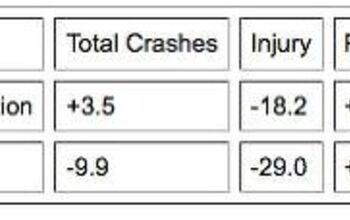California: Accidents Increase at Photo Enforced Intersections
The city council in Highland, California decided three years ago to allow an Australian company, Redflex Traffic Systems, issue tickets at two intersections. Nearly 4300 “violations” have been generated since August 2008, each worth nearly $500. A committee of the council opened debate yesterday on whether the automated ticketing machine contract should be renewed. When the same question was debated last year, officials focused on safety.
“We’ve seen a reduction in serious traffic collisions where the cameras were installed,” Highland City Manager Joe Hughes told the Riverside Press-Enterprise newspaper in May.
More complete data show that this statement was not true and that red light cameras have had no clear, positive impact on intersection safety in Highland. The claim regarding “serious accidents” is undermined by the city’s current admission that accidents at the photo enforced intersections have always tended to be minor.
“Before and after the installation of the red light cameras we have had very few injury accidents at these intersections,” an April 12 presentation by Highland Police Captain Dave Williams stated. “Most accidents are non-injury.”
At the intersection of Highland Avenue and Victoria Avenue, the average number of accidents in the three years before installation of cameras was 7.7 per year. In the two full years following installation, the average increased 23 percent to 9.5. The raw number of injury accidents increased from 2 to 3 over the same periods. At Base Line Street and Sterling Avenue the accident rate was 5.7 prior to camera use and 8.5 after the devices were installed — a 50 percent increase. Injury accidents also increased from 2 to 4.
The small overall number of accidents makes it difficult to draw statistically significant conclusions, but the figures also show that Highland moved to install the red light cameras at Base Line Street and Sterling Avenue even though no accident at the location had ever been attributed by police investigators to red light running. At Highland Avenue and Victoria Avenue, there were just two such accidents in three-and-a-half years.
The city presentation suggests that because accidents in 2010 were not quite as high as in 2009 that collisions are “reverting back to normal levels” because drivers are becoming accustomed to the presence of the cameras. At the same time, accidents nationwide are down to an all-time low because of high unemployment and high gas prices have reduced the amount of driving.
[Courtesy: Thenewspaper.com]
More by The Newspaper
Latest Car Reviews
Read moreLatest Product Reviews
Read moreRecent Comments
- Kjhkjlhkjhkljh kljhjkhjklhkjh A prelude is a bad idea. There is already Acura with all the weird sport trims. This will not make back it's R&D money.
- Analoggrotto I don't see a red car here, how blazing stupid are you people?
- Redapple2 Love the wheels
- Redapple2 Good luck to them. They used to make great cars. 510. 240Z, Sentra SE-R. Maxima. Frontier.
- Joe65688619 Under Ghosn they went through the same short-term bottom-line thinking that GM did in the 80s/90s, and they have not recovered say, to their heyday in the 50s and 60s in terms of market share and innovation. Poor design decisions (a CVT in their front-wheel drive "4-Door Sports Car", model overlap in a poorly performing segment (they never needed the Altima AND the Maxima...what they needed was one vehicle with different drivetrain, including hybrid, to compete with the Accord/Camry, and decontenting their vehicles: My 2012 QX56 (I know, not a Nissan, but the same holds for the Armada) had power rear windows in the cargo area that could vent, a glass hatch on the back door that could be opened separate from the whole liftgate (in such a tall vehicle, kinda essential if you have it in a garage and want to load the trunk without having to open the garage door to make room for the lift gate), a nice driver's side folding armrest, and a few other quality-of-life details absent from my 2018 QX80. In a competitive market this attention to detai is can be the differentiator that sell cars. Now they are caught in the middle of the market, competing more with Hyundai and Kia and selling discounted vehicles near the same price points, but losing money on them. They invested also invested a lot in niche platforms. The Leaf was one of the first full EVs, but never really evolved. They misjudged the market - luxury EVs are selling, small budget models not so much. Variable compression engines offering little in terms of real-world power or tech, let a lot of complexity that is leading to higher failure rates. Aside from the Z and GT-R (low volume models), not much forced induction (whether your a fan or not, look at what Honda did with the CR-V and Acura RDX - same chassis, slap a turbo on it, make it nicer inside, and now you can sell it as a semi-premium brand with higher markup). That said, I do believe they retain the technical and engineering capability to do far better. About time management realized they need to make smarter investments and understand their markets better.


































Comments
Join the conversation
Californians, watch your asses. Your state government is broke, and probably also your city and county governments. They see every citizen as a potential source of fines and taxes. Maybe I should have said "every driver".
On Long Island, New York, Nassau County has just completed a 100 intersection scamera system. At $50 per, the cash strapped county is milking its residents. All I can say is "Destroy"